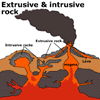Note: All pictures are meant as guides only, as often the difference between one igneous rock type and another is only in the size of the grains or crystals.
 Most
people have seen the spectacular images of a volcanic eruption and the
lava that often flows down the sides of volcanoes at high speed. What
happens to this lava as it cools? As with any liquid, it will eventually
solidify when its temperature is low enough.
Most
people have seen the spectacular images of a volcanic eruption and the
lava that often flows down the sides of volcanoes at high speed. What
happens to this lava as it cools? As with any liquid, it will eventually
solidify when its temperature is low enough.
A rock that forms as a result of solidification from a liquid is classified as an igneous rock. This solidification may occur on the surface of the Earth, as with volcanoes, or it may occur deep underground. As the liquid starts solidifying, crystals of minerals will grow. The size of these crystals will be determined by how slowly the liquid cools; the slower the cooling, the larger the crystals.
Classification
Igneous rocks are classified according to where they form and by their
chemical composition. Chemical make up is reflected in the colour of the
rock, while the deeper the rock forms in the Earth, the harder and denser
it becomes.
 As
we go deeper into the Earth, both temperature and pressure increase significantly.
Indeed, the temperature is high enough at depths of several kilometres
to melt rocks. Such molten rock (magma) is lighter than the surrounding
solid rock and so tends to move towards the surface along weaknesses in
the crust. As it ascends, its temperature decreases and eventually it
will solidify. If it solidifies before it reaches the surface, under the
ground, it is classified as intrusive, but if it reaches the surface and
solidifies on the surface, it is classified as extrusive.
As
we go deeper into the Earth, both temperature and pressure increase significantly.
Indeed, the temperature is high enough at depths of several kilometres
to melt rocks. Such molten rock (magma) is lighter than the surrounding
solid rock and so tends to move towards the surface along weaknesses in
the crust. As it ascends, its temperature decreases and eventually it
will solidify. If it solidifies before it reaches the surface, under the
ground, it is classified as intrusive, but if it reaches the surface and
solidifies on the surface, it is classified as extrusive.
Intrusive igneous rocks
Magma that stays beneath the surface of the Earth tends to cool very slowly,
giving crystals in the rock more time to grow, so intrusive rocks tend
to have large grains or crystals of a uniform size.
 Rocks
that cool deep inside the Earth are sometimes called plutonic. They are
usually very coarse grained and individual crystals of minerals are easily
seen. Examples include granite that is very light in colour and the much
darker rock called gabbro.
Rocks
that cool deep inside the Earth are sometimes called plutonic. They are
usually very coarse grained and individual crystals of minerals are easily
seen. Examples include granite that is very light in colour and the much
darker rock called gabbro.
 Rocks
that cool more quickly at shallower depths contain smaller crystals, but
they can usually still be seen. Examples include light coloured aplite
and darker coloured dolerite.
Rocks
that cool more quickly at shallower depths contain smaller crystals, but
they can usually still be seen. Examples include light coloured aplite
and darker coloured dolerite.
Extrusive rocks
Magma that reaches the surface before it solidifies is called lava and
is typically extruded from volcanoes. As you might expect, this lava cools
much more quickly than magma deep inside the Earth, so extrusive rocks
are usually have a much smaller grain size. Individual crystals are often
too small to be seen with the naked eye.
The most common extrusive rock is dark coloured basalt, but lighter examples such as andesite and rhyolite also exist. If the lava has a very high gas content, it may turn into froth before it solidifies and forms pumice. Pumice is so light that it actually floats on water.
| Copyright owned by the State of Victoria (Department of Education and Early Childhood Development). Used with Permission. |

